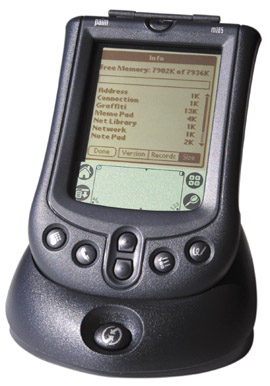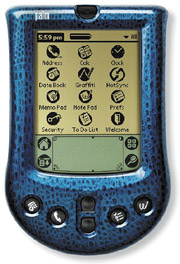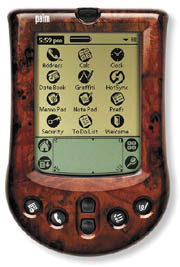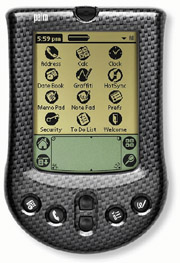Palm m105
Entry level model gets enhancements and new faceplates
by Shawn Barnett

March 6, 2001
Marking the first upgrade in Palm's new naming system, the Palm m105 sports a few enhancements over the original m100, though physically it looks the same. Most notable among the improvements is the full 8MB of RAM, making the m105 a considerably more spacious model than its predecessor.
It also has a cradle, something omitted from the original m100 (it came with only a HotSync cable). The cradle, available as a US$25 accessory, is the most attractive to date. It sits on the desk with a strong presence, not looking quite as empty as other cradles in the line.
These two items alone--more memory and an actual cradle--make this package a great value at only US$50 more than the m100. But there's more.

The m105 adds a feature that helps it rival its big brother the Palm VIIx: the Palm Mobile Internet Kit (MIK). With this little package, users can use many different types of cell phones to connect to the Internet using the Web Clipping Applications that used to be the exclusive domain of Palm VII handhelds. Connection between the m105 and a cell phone is made with either cable or infrared, depending on the cell phone's capability. Even TDMA phones are supported. The MIK is available for other Palms, but the m105 is the first to ship bundled with the product.
For those unfamiliar with the m100 on which the m105 is based, I'll give a brief summary of its features. The m100 replaces the Palm IIIe that used to occupy the low end of the Palm line. Its swoopy case is designed to appeal to a more broad market than its predecessors, and users can purchase custom faceplates that snap on and off easily, emulating and improving upon the Nokia cell phone craze.

The m100 series has a flip lid that also snaps on and off easily. It introduced a new application as well: the Note Pad, which takes over the right-most button from the Memo Pad that appears on all other Palms. With the Note Pad, users can scribble a note in virtual ink and assign an alarm to the note so that it pops up at a given time. It's an entry-level feature designed to appeal to those uncomfortable with Graffiti.
The screen on the m100 series is smaller than any before it, though that doesn't seem to deter its target market. The m100 is now for sale in Target stores, hanging on a peg in a blister pack. There is every reason to believe that the m105 will soon join it.

A common complaint about the m100 and Palm IIIe, as well as the Visor handhelds by Handspring, is that there is no Flash RAM for future OS upgrades. While that's true, there's a US$100 premium to rise to that upgradeability in the Palm IIIxe, so for many it just won't matter. (Rumor has it that the IIIxe will no longer be produced, but that has not been confirmed.) Combined with the hot new color faceplates--including Carbon Tek, Burl Wood, Bubble Gum, Blue Boa, Turbo Red, and Leopard--the m105's 8MB, light weight, extra-loud speaker, durable screen, and low price tag will make it even more popular than ever. US$199. www.palm.com
-Shawn Barnett
Back to Palm Section

